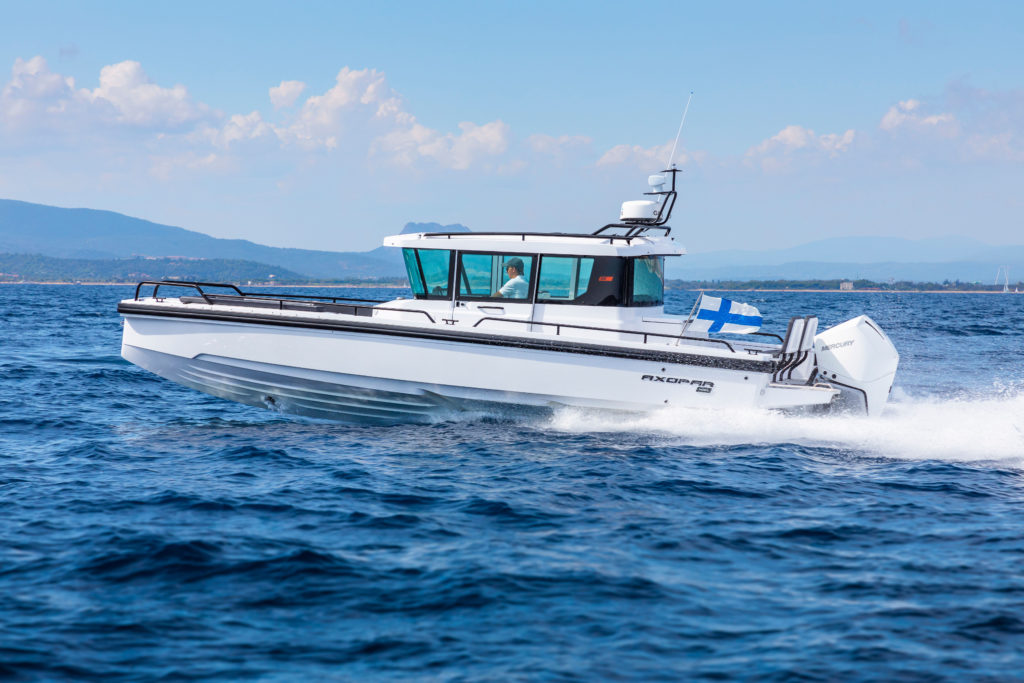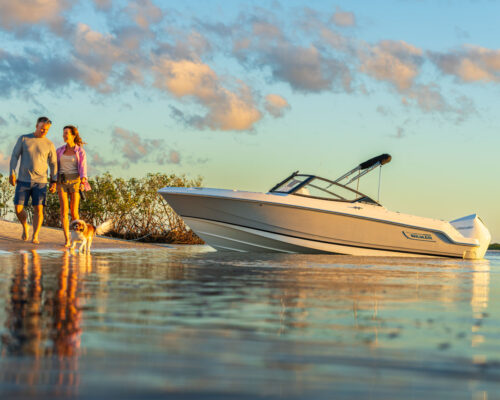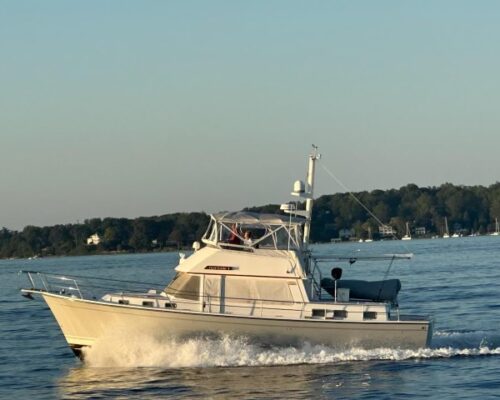Rakish. That’s a good word to describe the Axopar 28: a bow entry that looks as sharp as an axe-head under a vertical stem; prominent triple lifting strakes interrupted by a bow thruster; wide double chines; two ventilating steps across the bottom amidships. A bird’s-eye view shows a narrow wedge of a hull. A West Coast-style pilothouse sports a rain-shedding, backward-sloping windshield. To a classically minded boater, the Axopar 28 Cabin looks downright radical. But take a ride and the design’s logic comes together perfectly. Built in Poland by a company based in Helsinki, Finland, this boat is purpose-built to perform well as an all-weather island commuter or a multi-function utility boat in its native Baltic Sea, a large Northern European estuary that bears striking similarities to the Chesapeake. Axopar’s founders are paddlers, rock climbers and mountain bikers. No wonder, then, that they build these boats to go places and do adventurous things, including adding cabin-top racks for bikes, boards, and kayaks. The radical-looking hull is impressively effective, a product of sophisticated, computer-aided design that includes both numerical analysis of hydrodynamic flow patterns around the strakes and steps as well as careful weight distribution analysis.
The designers deliberately kept the narrow bow light, with the pilothouse’s weight centered amidships and a broad aft section to carry the outboard (on our sea trial, a single 300-hp V-8 Mercury Verado) and its considerable thrust. (Twin 200-hp Mercury V-6s are optional.) As a result, the 28 rises easily onto plane with almost no bow rise. In our sea trial with Lloyd Cooper, the Axopar dealer who runs the Annapolis office of East Coast Yacht Sales, we found our test boat reasonably efficient at speeds in the mid-teens, should nasty conditions dictate slowing that much. She was happiest between 20 and 32 knots (4100–4500 rpm), where the smooth, powerful Merc burns 9–12 gallons per hour, giving the 28 Cabin a range of more than 160 nautical miles. Credit the two steps for a good chunk of that efficiency. Top end at 5860 rpm was 43 knots.
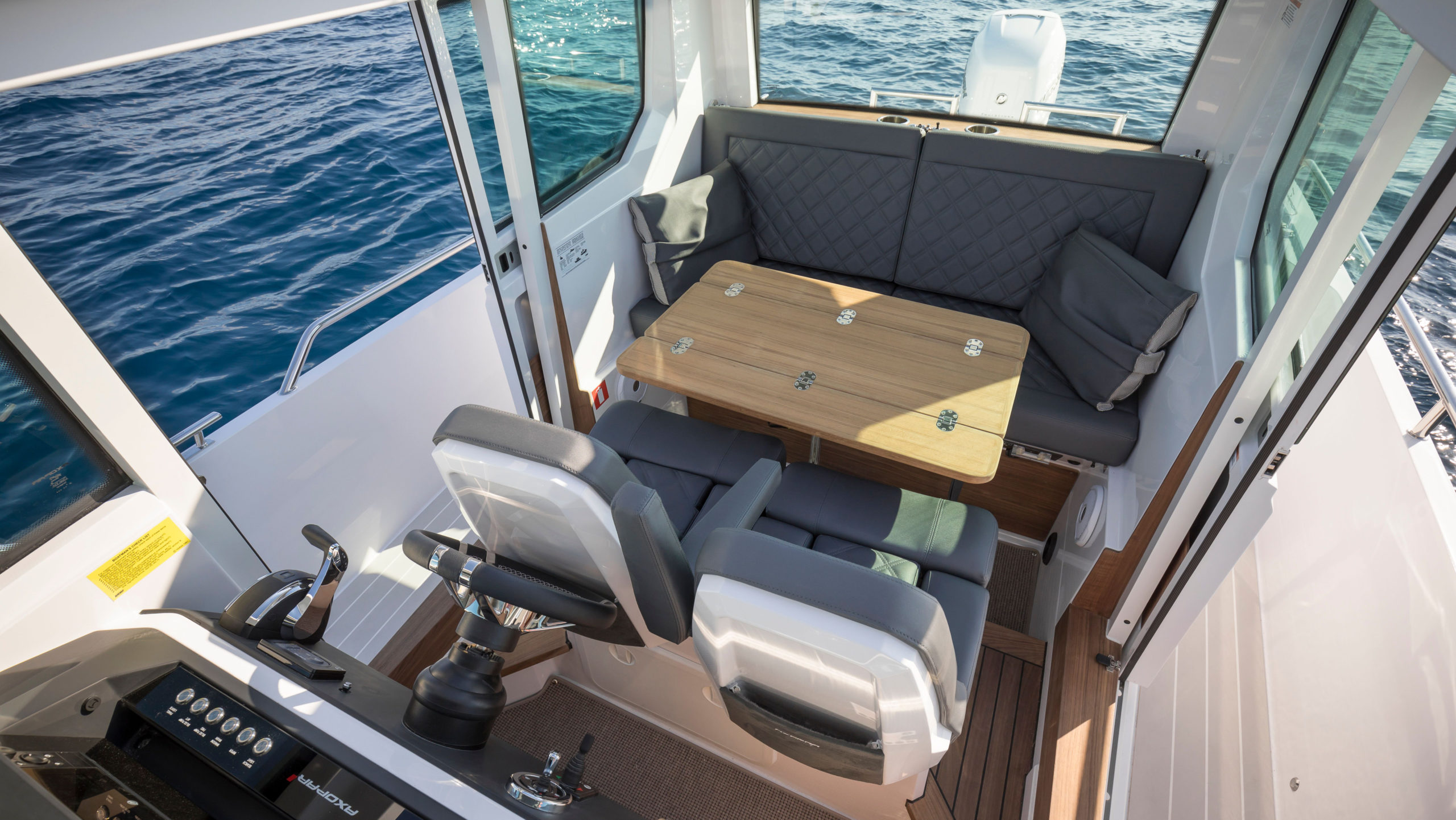
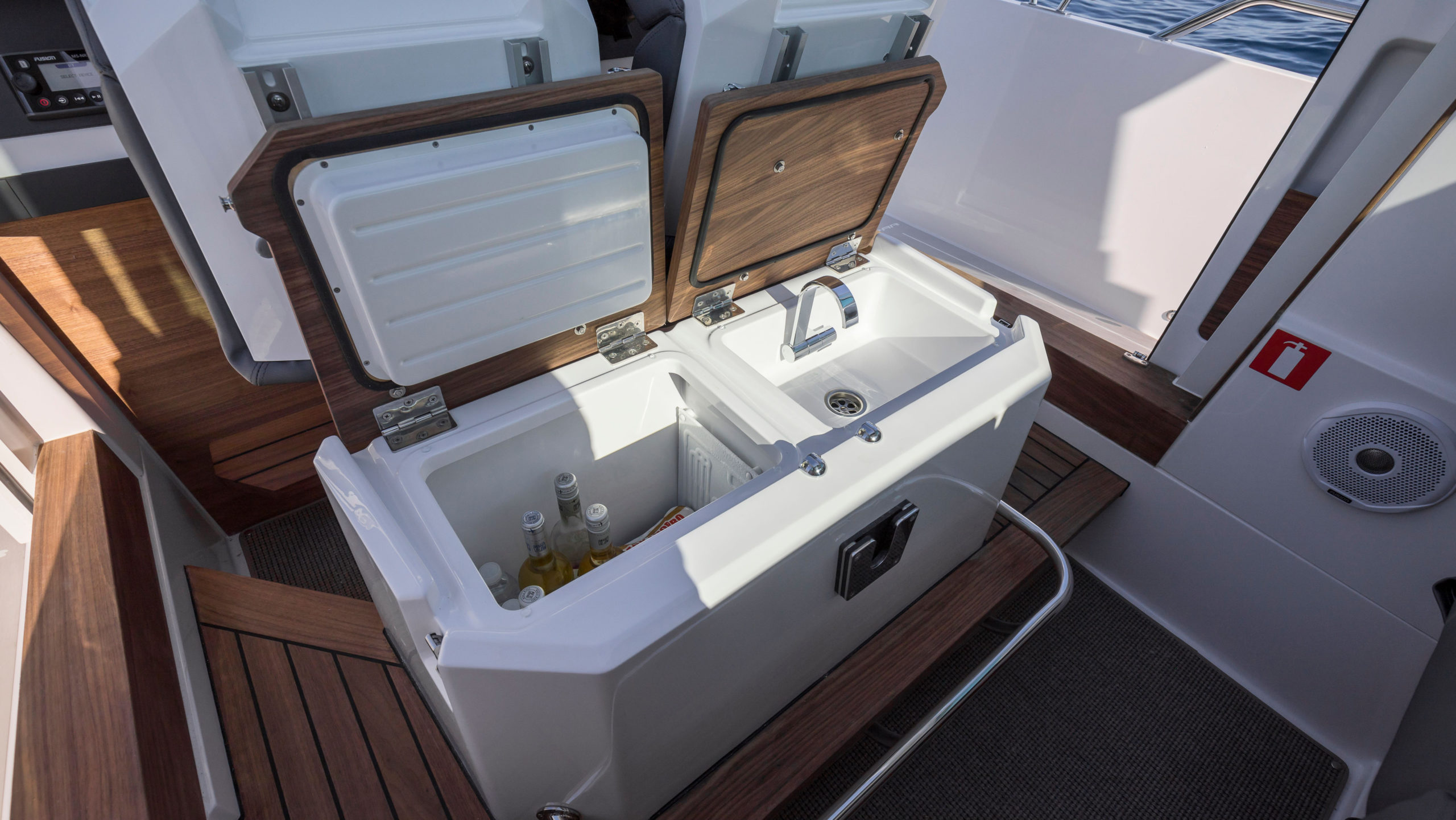
We ran out to the open Bay on a day with northwest winds of around 10 knots and slid her through a couple of steep powerboat wakes at speeds in the upper twenties. Sitting in the pilothouse, we found the ride soft and dry. The sharp, 22-degree keel under the running bottom held the boat in tight turns, while the ultra-sharp, 60-degree bow sliced through the wakes head-on. Even more impressive was the way the subtle cutaway shape of the hull’s forward section provided enough buoyancy to ease over the other sides of the wakes, simulating sliding down the backs of following seas without any tendency to broach. Axopar’s design team clearly knows what it is doing with this complex shape. Oh, yes, and spray? None made it above those chines, especially the five-inch-wide upper ones. Performance of this boat’s hull is a tribute not only to its designers but also to the lamination crews that ensure each hull precisely follows the intricate shape and sharp edges of the design, so that water flows past it as intended.
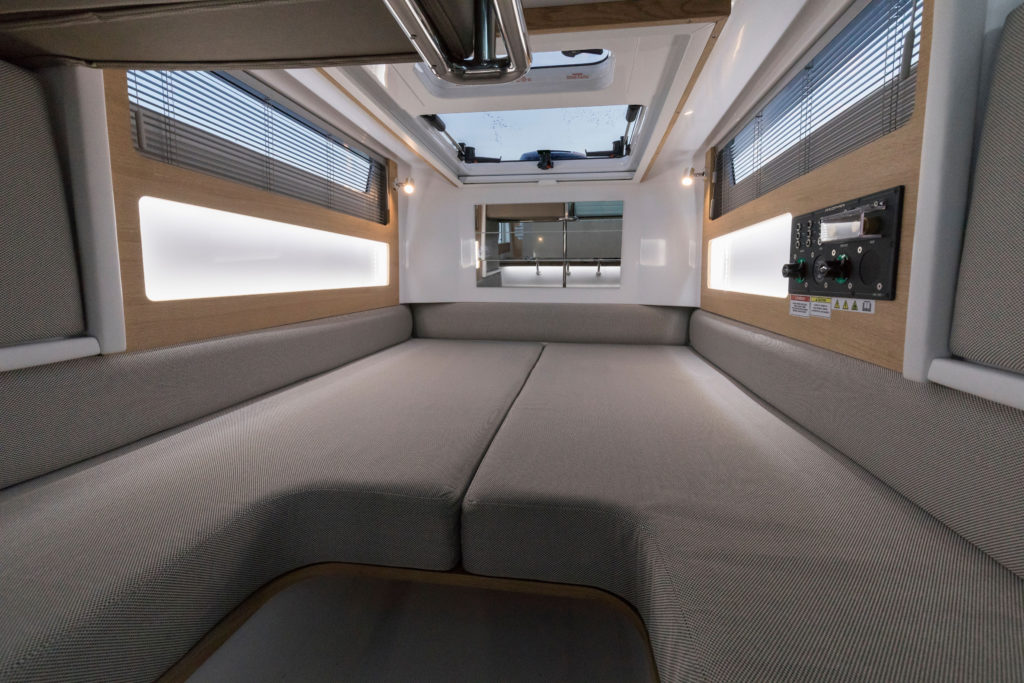
But there’s more. Laminating the 28 Cabin’s deck-and-cabin part is even more intricate, requiring serious craftsmanship to ensure that this yet more complex shape includes all of the storage lockers, ledges, and pilothouse. It too must be precise to fit tightly into the hull and onto the stringer grid. Axopar actually makes molding this process modular to provide multiple layouts for the 28 hull, including this one, in which the cabin fits into the cockpit sole after the pilothouse. Options include an open cockpit with aft-facing storage box and seat cushion above or a wet bar. The transom is open, with boarding/swimming platforms extending aft on either side of the engine. Either way, the crews apparently do their jobs well. Our test boat ran solid as a rock.
Accommodations begin with the bow, which though narrow is seriously adaptable. There’s an anchor locker in the forepeak, with a windlass available. A portside bench with storage under and a table form a picnic spot, but the table can lower partway to create a sunpad or a casting deck with the addition of a triangular part that fits onto a ledge molded into the starboard hullside. For maximum space, the table drops into a recess in the sole. A roll-up canopy is available to shade the area when the boat is on the hook. The front side of the pilothouse holds a head compartment with a wide swinging door. Inside, the bright, roomy compartment has comfortable sitting headroom on the toilet (portable with pumpout or porcelain with holding tank), a large vent, and a cabinet with counter and sink.
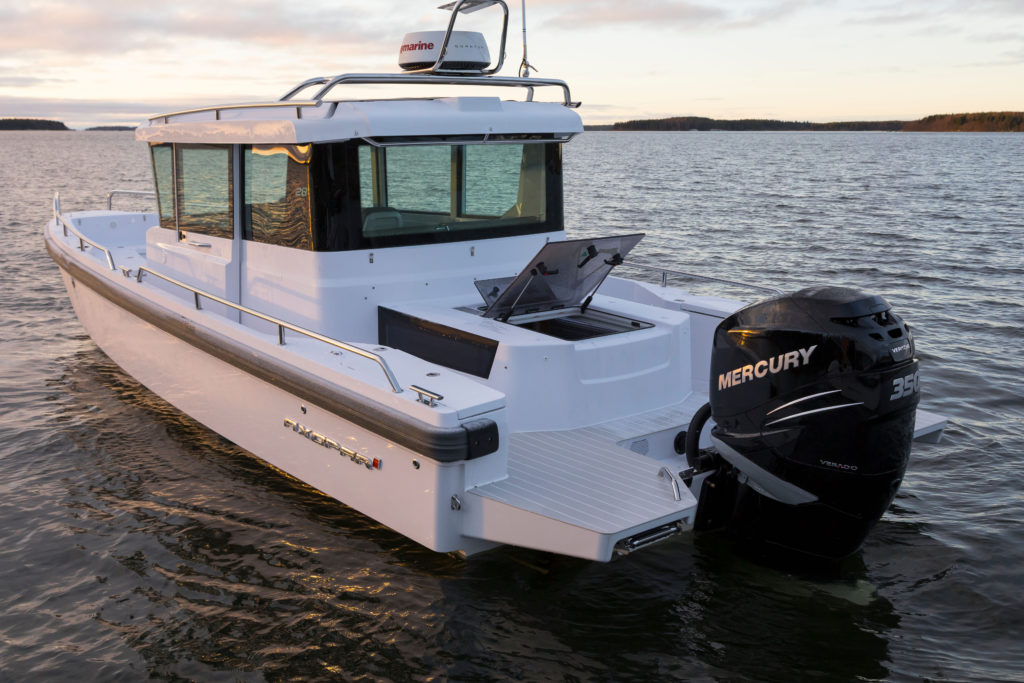
Sliding doors port and starboard offer access to the helm, which holds one or two 12-inch Simrad electronic displays integrated with the Mercury outboard. Radar is optional. Two comfortable seats hold the skipper and a companion. They include flip-up bolsters for standing and leaning, and they fold forward to reveal a freshwater sink and a cooler below. They also swivel to face the two rear seats against the pilothouse’s aft bulkhead, with a table available between to serve all four. A folding top overhead opens the cabin completely if desired, but when closed it is completely weather-tight. For cruising in the cabin model, the portside after seat swings up to reveal a 75″ X 60″ double bunk with 29″ of headroom. The space is bright, with windows on each side and an overhead skylight hatch that can open for ventilation or standing. The hatch also comes in handy for anyone who needs access under the bunk to the plumbing and wiring systems in the bilge. The accommodations are spartan but comfortable enough for ingenious and adventurous souls. Lloyd Cooper and his wife have an infant daughter and plan on cruising the Chesapeake with her this summer.
Technically, Axopar’s pilothouse models qualify as commuters for all-weather transit to islands and other remote locations. The Baltic has more of them than the Chesapeake, but we could see this boat filling that role, say, for someone in the Washington, D.C., area with a weekend house on Smith Island and a shoreside slip somewhere around Point Lookout to berth her during the week. Otherwise, the 28 Cabin could fill all sorts of jobs, from long-legged family day explorations and Saturday race committee jobs to most forms of Bay fishing. She would be especially effective for light-tackle jigging.
Price for the Axopar 28 Cabin with a single 300-hp Mercury ranges between $210,000 and $250,000, depending on options.

